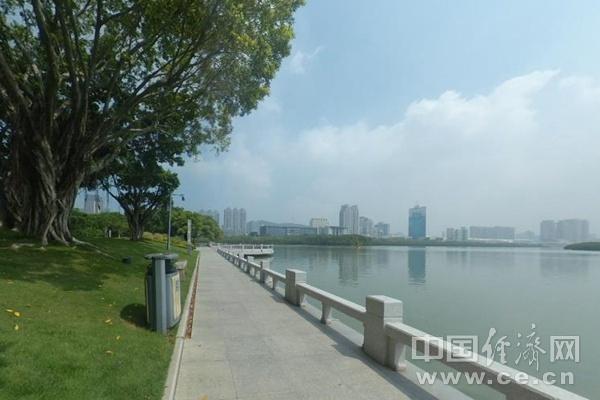The picture shows the Xiang’an Bamboo Lake in Xiamen (China Economic Net, Mengya Yue / Photography).
A decade after the release of the ‚Ten Waters Policy,‘ another significant water governance document has been introduced. Recently, the ‚Beautiful Rivers and Lakes Protection and Construction Action Plan (2025-2027)‘, jointly researched and developed by the Ministry of Ecology and Environment, the National Development and Reform Commission, the Ministry of Finance, and seven other departments, has been officially released.
Mentioning beautiful rivers and lakes, we cannot help but think of the enchanting scenes in the poetry, ‚The river flows outside heaven and earth, the mountain colors are endless,‘ ‚The vapor mists the cloud dreams of Cetang, the waves touching the Yueyang city’… From the perspective of development planning, what does a beautiful river and lake look like? According to the responsible person of the Ministry of Ecology and Environment explaining the ‚Action Plan‘, beautiful rivers and lakes align with the vision of ‚clear waters and green shores, fish soaring in shallow waves‘. Effective protection of water resources, water environment, and aquatic ecosystems in the watershed, leading to significant improvements, and the people’s ecological environment will enhance their sense of satisfaction, happiness, and safety, realizing harmonious water landscapes.
Beautiful rivers and lakes are an integrated manifestation and important carrier of beautiful China in the domain of aquatic ecological environments. Since launching the construction of beautiful rivers and lakes in 2021, various regions have been advancing step by step, and have shortlisted exemplary cases such as the Maozhou River in Shenzhen, the Yundang Lake in Xiamen, and the Thousand Islands Lake in Zhejiang among 94 beautiful rivers and lake cases.
The significance of constructing beautiful rivers and lakes lies not only in ecological governance, but also focuses on economic livelihood and the people’s well-being. For instance, the governance of the Maozhou River in Shenzhen released 15 square kilometers of riverside space, strategically planning small urban complexes, high institute campuses, and high-tech industry areas, attracting over 180 technology enterprises. Similarly, the Yundang Lake area in Xiamen improves sewage treatment and flood prevention functions, and builds parks and green spaces along the lake, establishing a white egret nature reserve, realizing a coordinated unity of lake area’s ecological views and flood control embankments.
Transforming ‚ecological benefits‘ into ‚economic benefits‘, then ‚economic vitality‘ reciprocally nurtures the new ‚ecology‘, this is a straightforward philosophical principle. The conversion of ecological value requires continuous innovation, in this way, ecology can be a sustainable and meaningful endeavor. In fact, such endeavors are being explored in places like Zhejiang’s Shaoxing and Jinhua. They actively explore mutually reinforcing mechanisms between golden mountains and silver mountains with green waters and blue mountains, reinvesting the capital generated by transformed ecological values back into water ecology improvement efforts, aiming to further motivate society’s enthusiasm for water conservation and governance.
Promoting the protection and construction of beautiful rivers and lakes requires a balanced governance approach. Cross-regional cooperation stands as a significant challenge in river and lake governance. This ‚Action Plan‘ proposes promoting entire basin upstream and downstream, left and right banks, and main and tributary joint management, aiming to ensure effective protection of cross-provincial significant ecological flow by 2027. It aims to advance systemic governance of river basins, deepen cross-regional cooperation, and continuously explore integrated management and diverse cooperative mechanisms for the whole basin. Promoting the protection and construction of beautiful rivers and lakes also needs to adhere to classified policy application. Therefore, the ‚Action Plan‘ encourages locals to incorporate even small water bodies around the public into the protective construction scope, clarifying construction requirements.
Today, the focus of the ‚Action Plan‘ is on improving quality and efficiency, addressing not only water pollution management but also water ecological restoration and other issues. May 22 marks the International Day for Biological Diversity, with this year’s theme ‚From Agreement to Action: Build Back Biodiversity‘. Against this backdrop, discussing the ‚Protection and Construction of Beautiful Rivers and Lakes‘ adds even greater significance. Governing river and lake ecology precisely means maintaining biodiversity, which in turn protects the human race itself.
As the masses enjoy ‚green outside windows and views upon opening doors‘, and as more places achieve ‚harmonious water landscapes‘ through ‚clear waters and green shores‘, beautiful rivers and lakes will become happiness rivers and lakes that bless the people, making ‚poetry and distance‘ not just an ideal vision, but a tangible daily life. (China Economic Net Commentator Mengya Yue)



